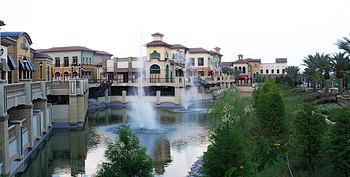Doctor Phillips, Florida
| Dr. Phillips, Florida | |
|---|---|
| Census-designated place | |

Sand Lake Road on Restaurant Row.
|
|
 Location in Orange County and the state of Florida |
|
| Coordinates: 28°27′22″N 81°29′35″W / 28.45611°N 81.49306°WCoordinates: 28°27′22″N 81°29′35″W / 28.45611°N 81.49306°W | |
| Country |
|
| State |
|
| County | Orange |
| Area | |
| • Total | 4.9 sq mi (12.6 km2) |
| • Land | 3.4 sq mi (8.8 km2) |
| • Water | 1.5 sq mi (3.8 km2) |
| Elevation | 121 ft (37 m) |
| Population (2010) | |
| • Total | 10,981 |
| • Density | 2,200/sq mi (870/km2) |
| Time zone | Eastern (EST) (UTC-5) |
| • Summer (DST) | EDT (UTC-4) |
| FIPS code | 12-17725 |
| GNIS feature ID | 1867136 |
Dr. Phillips is a census-designated place and an unincorporated area in Orange County, Florida, United States. It is a suburb of Orlando and is part of the Orlando–Kissimmee–Sanford, Florida Metropolitan Statistical Area. The population was 10,981 at the 2010 census.
The area of Dr. Phillips is named after Dr. Phillip Phillips, a Central Florida citrus magnate. He was responsible for several key innovations in the processing and packaging of orange juice. By the early 1920s, he owned thousands of acres of groves, stretching across nine Central Florida counties and extending from Conroy Road on the north to the south end of the Sand Lake Chain, encompassing all of what is now Bay Hill, Orange Tree, Sand Lake Hills, Clubhouse Estates and Turkey Lake Park.
According to the United States Census Bureau, the CDP has a total area of 12.6 km² (4.8 mi²), of which 8.8 km² (3.4 mi²) is land and 3.8 km² (1.5 mi²) (29.90%) is water.
As of the census of 2000, there were 9,548 people; 3,451 households; and 2,691 families residing in the CDP. The population density was 1,084.3/km² (2,808.4/mi²). There were 3,769 housing units at an average density of 428.0/km² (1,108.6/mi²). The racial makeup of the CDP was 84.14% White; 3.05% African American; 0.06% Native American; 8.46% Asian; 0.03% Pacific Islander; 1.94% from other races; and 2.31% from two or more races. Hispanic or Latino of any race were 8.36% of the population.
...
Wikipedia
